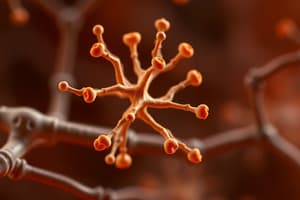Podcast
Questions and Answers
What is the effect of histamine on smooth muscles?
What is the effect of histamine on smooth muscles?
- Relaxation of smooth muscles
- Contraction of smooth muscles (correct)
- Increased permeability of smooth muscles
- No effect on smooth muscles
Which of the following is NOT a vascular effect of histamine?
Which of the following is NOT a vascular effect of histamine?
- Erythema in skin
- Dilation of capillaries
- Vasoconstriction (correct)
- Leaky capillaries
What is a common side effect of 1st generation antihistamines?
What is a common side effect of 1st generation antihistamines?
- Urinary retention
- Dry mouth (correct)
- Tachycardia
- Hypertension
What is an advantage of 2nd generation antihistamines?
What is an advantage of 2nd generation antihistamines?
Which of the following is a less common side effect of antihistamines?
Which of the following is a less common side effect of antihistamines?
What is the mechanism of action of antihistamines?
What is the mechanism of action of antihistamines?
Which of the following is NOT an indication for antihistamines?
Which of the following is NOT an indication for antihistamines?
What is the effect of histamine on the heart?
What is the effect of histamine on the heart?
What is the primary target of allergies?
What is the primary target of allergies?
What is the term for a severe, life-threatening allergic reaction?
What is the term for a severe, life-threatening allergic reaction?
What is the primary mechanism of action of antihistamines?
What is the primary mechanism of action of antihistamines?
What is a common side effect of antihistamines?
What is a common side effect of antihistamines?
What is the primary function of the scribe in the terminology exercise?
What is the primary function of the scribe in the terminology exercise?
In the disease support meeting, what is the focus of the student presentations?
In the disease support meeting, what is the focus of the student presentations?
What is the purpose of the terminology exercise in groups?
What is the purpose of the terminology exercise in groups?
What will be released after the class according to the lecture notes?
What will be released after the class according to the lecture notes?
What is the mechanism of action of Cromolyn Sodium?
What is the mechanism of action of Cromolyn Sodium?
Which of the following antihistamines has the highest potential for CNS stimulation?
Which of the following antihistamines has the highest potential for CNS stimulation?
What is the common side effect of Ethanolamines?
What is the common side effect of Ethanolamines?
Which of the following is NOT a side effect of Phenothiazines?
Which of the following is NOT a side effect of Phenothiazines?
What is the primary use of Hydroxyzine?
What is the primary use of Hydroxyzine?
What is the indication for Cromolyn Sodium in food allergies?
What is the indication for Cromolyn Sodium in food allergies?
Which of the following is NOT a brand name of Cromolyn Sodium?
Which of the following is NOT a brand name of Cromolyn Sodium?
What is the primary mechanism of action of Mast Cell Stabilizers?
What is the primary mechanism of action of Mast Cell Stabilizers?
Flashcards are hidden until you start studying
Study Notes
Allergens and Antibodies
- An allergen is a substance that causes an allergic reaction
- An antigen is a substance that triggers an immune response
- An antibody is a protein produced by the body to fight against an antigen
Allergy Symptoms
- Rhinitis: inflammation of the nasal passages
- Urticaria: itchy, raised patches on the skin
- Xerostomia: dry mouth
- Anaphylaxis: a severe, life-threatening allergic reaction
Histamine
- Histamine is a chemical mediator released by mast cells during an allergic reaction
- Histamine causes:
- Vasodilation and increased permeability of blood vessels, leading to hypotension and fluid leakage
- Contraction of smooth muscles, leading to bronchoconstriction and gut cramps
- Rapid heart rate and arrhythmias
Antihistamines
- Antihistamines are medications that counteract the effects of histamine
- Indications for antihistamines:
- Acute allergic reactions
- Rhinitis, dermatitis, itchy eyes, scratchy throat, and urticaria
- Dry nasal secretions
- Sedation and sleep aids
- Reduction of nausea and vomiting, including motion sickness
First Generation Antihistamines
- Sedating effects
- Anticholinergic effects
- Examples:
- Ethanolamines: most sedating, highest anticholinergic effects (e.g., Dimenhydrinate, Diphenhydramine)
- Alkylamines: highest potential for CNS stimulation, medium for epigastric distress (e.g., Chlorpheniramine)
- Phenothiazines: high anticholinergic effects, moderate sedation (e.g., Promethazine)
- Other first-generation antihistamines: Hydroxyzine
Second Generation Antihistamines
- Less sedating
- Less anticholinergic effects
- Examples:
- Cetirizine
- Fexofenadine
- Loratadine
- Desloratadine
Antiallergic Agents
- Cromolyn Sodium: prevents release of histamine through degranulation of mast cells
- Mechanism of action: mast cell stabilizer
- Indications:
- Prophylactic in chronic bronchial asthma, allergic rhinitis, food allergies, and allergic conjunctivitis
- Dosage forms and strengths: Nalcrom, Opticrom, Alocril
Studying That Suits You
Use AI to generate personalized quizzes and flashcards to suit your learning preferences.



